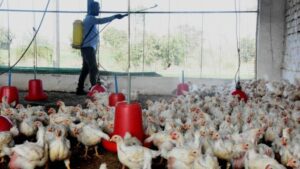H5N1 Outbreak Concerns
Context:
This year, the world has witnessed one of the worst reported outbreaks of highly virulent avian influenza H5N1, which has killed millions of birds. The virus, which is known to cause severe sickness and death in birds, has also been found in mammalian and human species.
Points to ponder:
- H5N1 is a highly virulent variant of avian influenza that kills birds. Since 2022, the virus has infected over 100 million birds worldwide, killing over 50 million and culling millions of poultry.

- The impact of H5N1 on wild bird populations has varied based on some factors, including the level of exposure, geographic location, and migratory habits of the affected species. The virus’s high mortality rate in wild birds could have serious ecological repercussions, including predator vulnerability and changes in species composition in affected environments.
- In recent weeks, reports indicate that at least 20 California condors, a species on the edge of extinction since the 1980s, have died from H5N1 avian influenza. H5N1 has also killed a substantial number of bald eagles and Caspian terns in the United States since January 2022, as well as thousands of cranes in Israel. Last year, H5N1 infected a colony of endangered African penguins in South Africa, killing at least 30 penguins.
- The highly contagious H5N1 virus can also occasionally spill over from birds to animals through direct or indirect contact with infected birds or their droppings. There have been several reports of spillover of H5N1 to mammals during the current outbreak from different countries, infecting species such as sea lions, minks, foxes, wild bears, and skunks, apart from domestic animals such as dogs and cats.
- Transmission of H5N1 from birds to mammals is uncommon, but when it does occur, it can be concerning since the virus may accumulate mutations and gain the ability to cause human outbreaks. H5N1 has a high fatality rate in humans of more than 60%, and it is primarily transmitted to people through direct contact with sick birds or animals.
- A few isolated cases of human H5N1 infection have been recorded in Ecuador, Cambodia, and, most recently, Chile in recent months. The World Health Organisation (WHO) has determined that the risk of H5N1 to people is low because the virus does not yet transmit efficiently among humans.
- Efforts to create effective vaccinations for avians and humans, as well as genetic surveillance to track the virus’s ongoing evolution, are critical. Enhanced biosecurity measures are also required to prevent the virus from spreading among animals and to reduce the danger of transmission to people.
- Recognising the ecological and economic ramifications of the H5N1 outbreak is critical, as is taking the required precautions to protect both animal and human health.





